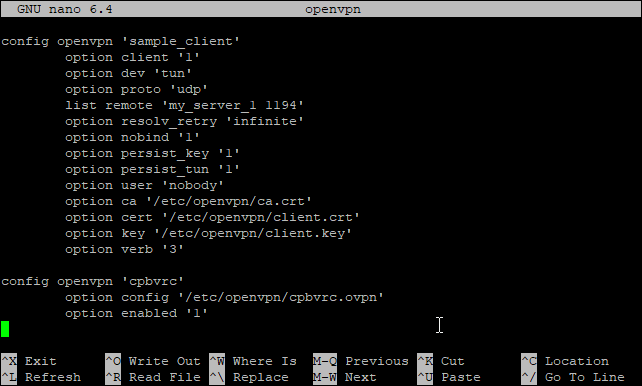Hello,
I flashed a TP Ling MR-6400 router to have OpenVPN as a client.
I manage to connect to the VPN well and I managed to get the connection to work, but with great difficulty.
But now after a restart I lose the TUN0 connection the interface is no longer detected.

I disconnected / reconnected the VPN and restarted the TUN0 interface but could not get the interface to reconnect.
I deleted and put back the interface it is connected but no connection and if I restart the router I lose the interface again.
I followed what is in this subject at the level of the config file and the .config everything is OK on this side.


I don't really see what to do to get my connection to the VPN working again.
I see attached logs.
Thank you for your help.
root@OpenWrt:~# uci show network; uci show firewall; uci show dhcp; uci show ope
nvpn
network.loopback=interface
network.loopback.device='lo'
network.loopback.proto='static'
network.loopback.ipaddr='127.0.0.1'
network.loopback.netmask='255.0.0.0'
network.globals=globals
network.globals.ula_prefix='fd48:253f:ec2c::/48'
network.@device[0]=device
network.@device[0].name='br-lan'
network.@device[0].type='bridge'
network.@device[0].ports='eth0.1'
network.lan=interface
network.lan.device='br-lan'
network.lan.proto='static'
network.lan.netmask='255.255.255.0'
network.lan.ip6assign='60'
network.lan.ipaddr='192.168.2.1'
network.wan=interface
network.wan.device='usb0'
network.wan.proto='dhcp'
network.wan6=interface
network.wan6.device='usb0'
network.wan6.proto='dhcpv6'
network.@switch[0]=switch
network.@switch[0].name='switch0'
network.@switch[0].reset='1'
network.@switch[0].enable_vlan='1'
network.@switch_vlan[0]=switch_vlan
network.@switch_vlan[0].device='switch0'
network.@switch_vlan[0].vlan='1'
network.@switch_vlan[0].ports='1 2 3 0t'
network.WANNET=interface
network.WANNET.proto='static'
network.WANNET.device='eth1'
network.WANNET.ipaddr='192.168.1.250'
network.WANNET.netmask='255.255.255.0'
network.WANNET.gateway='192.168.1.1'
network.WANNET.broadcast='192.168.1.255'
network.WANNET.dns='8.8.8.8'
network.TUN0=interface
network.TUN0.proto='none'
network.TUN0.device='tun0'
firewall.@defaults[0]=defaults
firewall.@defaults[0].syn_flood='1'
firewall.@defaults[0].input='ACCEPT'
firewall.@defaults[0].output='ACCEPT'
firewall.@defaults[0].forward='REJECT'
firewall.@zone[0]=zone
firewall.@zone[0].name='lan'
firewall.@zone[0].input='ACCEPT'
firewall.@zone[0].output='ACCEPT'
firewall.@zone[0].forward='ACCEPT'
firewall.@zone[0].network='lan'
firewall.@zone[1]=zone
firewall.@zone[1].name='wan'
firewall.@zone[1].input='REJECT'
firewall.@zone[1].output='ACCEPT'
firewall.@zone[1].forward='REJECT'
firewall.@zone[1].masq='1'
firewall.@zone[1].mtu_fix='1'
firewall.@zone[1].network='wan' 'wan6' 'WANNET' 'TUN0'
firewall.@forwarding[0]=forwarding
firewall.@forwarding[0].src='lan'
firewall.@forwarding[0].dest='wan'
firewall.@rule[0]=rule
firewall.@rule[0].name='Allow-DHCP-Renew'
firewall.@rule[0].src='wan'
firewall.@rule[0].proto='udp'
firewall.@rule[0].dest_port='68'
firewall.@rule[0].target='ACCEPT'
firewall.@rule[0].family='ipv4'
firewall.@rule[1]=rule
firewall.@rule[1].name='Allow-Ping'
firewall.@rule[1].src='wan'
firewall.@rule[1].proto='icmp'
firewall.@rule[1].icmp_type='echo-request'
firewall.@rule[1].family='ipv4'
firewall.@rule[1].target='ACCEPT'
firewall.@rule[2]=rule
firewall.@rule[2].name='Allow-IGMP'
firewall.@rule[2].src='wan'
firewall.@rule[2].proto='igmp'
firewall.@rule[2].family='ipv4'
firewall.@rule[2].target='ACCEPT'
firewall.@rule[3]=rule
firewall.@rule[3].name='Allow-DHCPv6'
firewall.@rule[3].src='wan'
firewall.@rule[3].proto='udp'
firewall.@rule[3].dest_port='546'
firewall.@rule[3].family='ipv6'
firewall.@rule[3].target='ACCEPT'
firewall.@rule[4]=rule
firewall.@rule[4].name='Allow-MLD'
firewall.@rule[4].src='wan'
firewall.@rule[4].proto='icmp'
firewall.@rule[4].src_ip='fe80::/10'
firewall.@rule[4].icmp_type='130/0' '131/0' '132/0' '143/0'
firewall.@rule[4].family='ipv6'
firewall.@rule[4].target='ACCEPT'
firewall.@rule[5]=rule
firewall.@rule[5].name='Allow-ICMPv6-Input'
firewall.@rule[5].src='wan'
firewall.@rule[5].proto='icmp'
firewall.@rule[5].icmp_type='echo-request' 'echo-reply' 'destination-unreachable' 'packet-too-big' 'time-exceeded' 'bad-header' 'unknown-header-type' 'router-solicitation' 'neighbour-solicitation' 'router-advertisement' 'neighbour-advertisement'
firewall.@rule[5].limit='1000/sec'
firewall.@rule[5].family='ipv6'
firewall.@rule[5].target='ACCEPT'
firewall.@rule[6]=rule
firewall.@rule[6].name='Allow-ICMPv6-Forward'
firewall.@rule[6].src='wan'
firewall.@rule[6].dest='*'
firewall.@rule[6].proto='icmp'
firewall.@rule[6].icmp_type='echo-request' 'echo-reply' 'destination-unreachable' 'packet-too-big' 'time-exceeded' 'bad-header' 'unknown-header-type'
firewall.@rule[6].limit='1000/sec'
firewall.@rule[6].family='ipv6'
firewall.@rule[6].target='ACCEPT'
firewall.@rule[7]=rule
firewall.@rule[7].name='Allow-IPSec-ESP'
firewall.@rule[7].src='wan'
firewall.@rule[7].dest='lan'
firewall.@rule[7].proto='esp'
firewall.@rule[7].target='ACCEPT'
firewall.@rule[8]=rule
firewall.@rule[8].name='Allow-ISAKMP'
firewall.@rule[8].src='wan'
firewall.@rule[8].dest='lan'
firewall.@rule[8].dest_port='500'
firewall.@rule[8].proto='udp'
firewall.@rule[8].target='ACCEPT'
dhcp.@dnsmasq[0]=dnsmasq
dhcp.@dnsmasq[0].domainneeded='1'
dhcp.@dnsmasq[0].boguspriv='1'
dhcp.@dnsmasq[0].filterwin2k='0'
dhcp.@dnsmasq[0].localise_queries='1'
dhcp.@dnsmasq[0].rebind_protection='1'
dhcp.@dnsmasq[0].rebind_localhost='1'
dhcp.@dnsmasq[0].local='/lan/'
dhcp.@dnsmasq[0].domain='lan'
dhcp.@dnsmasq[0].expandhosts='1'
dhcp.@dnsmasq[0].nonegcache='0'
dhcp.@dnsmasq[0].authoritative='1'
dhcp.@dnsmasq[0].readethers='1'
dhcp.@dnsmasq[0].leasefile='/tmp/dhcp.leases'
dhcp.@dnsmasq[0].resolvfile='/tmp/resolv.conf.d/resolv.conf.auto'
dhcp.@dnsmasq[0].nonwildcard='1'
dhcp.@dnsmasq[0].localservice='1'
dhcp.@dnsmasq[0].ednspacket_max='1232'
dhcp.lan=dhcp
dhcp.lan.interface='lan'
dhcp.lan.start='100'
dhcp.lan.limit='150'
dhcp.lan.leasetime='12h'
dhcp.lan.dhcpv4='server'
dhcp.lan.dhcpv6='server'
dhcp.lan.ra='server'
dhcp.lan.ra_flags='managed-config' 'other-config'
dhcp.wan=dhcp
dhcp.wan.interface='wan'
dhcp.wan.ignore='1'
dhcp.odhcpd=odhcpd
dhcp.odhcpd.maindhcp='0'
dhcp.odhcpd.leasefile='/tmp/hosts/odhcpd'
dhcp.odhcpd.leasetrigger='/usr/sbin/odhcpd-update'
dhcp.odhcpd.loglevel='4'
openvpn.custom_config=openvpn
openvpn.custom_config.config='/etc/openvpn/my-vpn.conf'
openvpn.sample_server=openvpn
openvpn.sample_server.port='1194'
openvpn.sample_server.proto='udp'
openvpn.sample_server.dev='tun'
openvpn.sample_server.ca='/etc/openvpn/ca.crt'
openvpn.sample_server.cert='/etc/openvpn/server.crt'
openvpn.sample_server.key='/etc/openvpn/server.key'
openvpn.sample_server.dh='/etc/openvpn/dh2048.pem'
openvpn.sample_server.server='10.8.0.0 255.255.255.0'
openvpn.sample_server.ifconfig_pool_persist='/tmp/ipp.txt'
openvpn.sample_server.keepalive='10 120'
openvpn.sample_server.persist_key='1'
openvpn.sample_server.persist_tun='1'
openvpn.sample_server.user='nobody'
openvpn.sample_server.status='/tmp/openvpn-status.log'
openvpn.sample_server.verb='3'
openvpn.sample_client=openvpn
openvpn.sample_client.client='1'
openvpn.sample_client.dev='tun'
openvpn.sample_client.proto='udp'
openvpn.sample_client.remote='my_server_1 1194'
openvpn.sample_client.resolv_retry='infinite'
openvpn.sample_client.nobind='1'
openvpn.sample_client.persist_key='1'
openvpn.sample_client.persist_tun='1'
openvpn.sample_client.user='nobody'
openvpn.sample_client.ca='/etc/openvpn/ca.crt'
openvpn.sample_client.cert='/etc/openvpn/client.crt'
openvpn.sample_client.key='/etc/openvpn/client.key'
openvpn.sample_client.verb='3'
openvpn.cpbvrc=openvpn
openvpn.cpbvrc.config='/etc/openvpn/cpbvrc.ovpn'
openvpn.cpbvrc.enabled='1'
